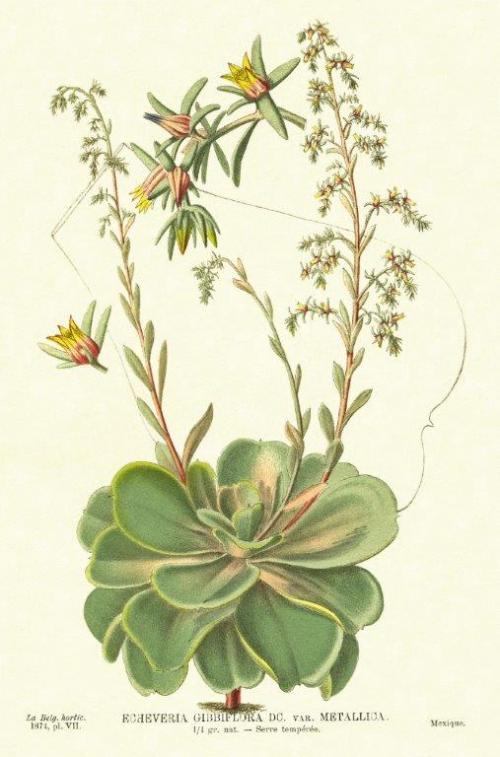GIBBIFLORA 'Metallica' (engl./ fr.)
In 1863, Echeveria metallica has been described and named by Lemaire from a plant in cultivation. His description was too brief to identify it. Baker (in Saunders Ref. Bot. 1869) gave a fuller description :
“General habit and flowers as in the type, but the leaves broader, the largest seven to seven and a half inches long by five to five and a half inches broad five-sixths of the way up, much rounded towards the apex, with a faint apiculus, not at all concave, when young a decided purplish lilac edged with glaucous-green, passing into a brownish bronzy green as they fade, the edge not at all crisped……. The plant was introduced from Mexico, some years since, by the late Hugh Cuming” – but this one is not recorded ever having visited Mexico.
This means it is an open question whether this plant has been a true species or already a hybrid produced in cultivation.
Regarding leaf colour, E. gibbiflora is a fairly variable species as photos of plants in habitat as well as in cultivation prove. However to claim that glaucous-green and purplish specimens found in the wild are identical with E. gibbiflora 'Metallica' Hort. is ignoring the fact that the colours of the latter were the result of cultivation in Europe, obviously rather different from habitat conditions in Mexico. To attribute legitimately this name to a plant in habitat in Mexico would require its cultivation in Europe to find out whether after a couple of years it would be a match to Lemaire's / Baker's description.
The caption of the photo in Pilbeam, The genus Echeveria, fig. 135, p.117, 2008, reads : "... matching well the lectotype painting in van Laren's book Vetplanten of 1932.
1. This photo does not show E. gibbiflora 'Metallica' and
2. therefore of course differs considerably from the painting in van Laren's book which itself is a good match for the plate from La Belgique Horticole (see below). And
3. the painting in question is not the lectotype because cultivars do not have lectotypes.
------------------------------------------------------------------------------------------------
En 1863, Echeveria metallica fut décrit et nommé par Lemaire à partir d'une plante cultivée. Sa description fut trop brève pour pouvoir l'identifier. Baker (dans Saunders Ref. Bot. 1869) en fit une plus ample description :
“ Aspect général et fleurs semblables à la plante type, mais avec de plus larges feuilles, les plus longues mesurant 17-19 cm, pour 12-14 cm de large et 2 cm d'épaisseur, très arrondies vers l'apex, avec un minuscule pointe, pas du tout concaves, et d'un vert glauque bordé de violet lilas, quand elles sont jeunes, virant au vert-marron bronze, les bords n'étant pas du tout ondulés [...] La plante fut rapportée du Mexique, il y a quelques années, par feu Hugh Cuming " – mais nous ignorons si ce dernier s'était rendu au Mexique.
Ce qui signifie que la question reste ouverte quant à savoir si cette plante est une vraie espèce ou un hybride déjà produit en culture. Prétendre qu'elle a été retrouvée au Mexique est quelque peu douteux. Le nom pourrait seulement être attaché à une telle plante si – après des années de culture au Royaume-Uni – elle correspondait aux descriptions de Lemaire et Baker.

Hand-coloured plate of Echeveria gibbiflora var. metallica from La Belgique Horticole 24: t.7. 1874.